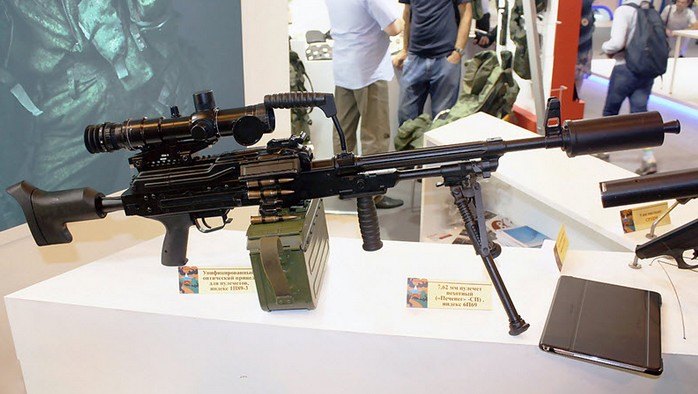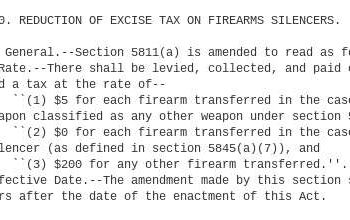The Russian 6P69 PKP-SP Special Forces Machine Gun

The V.A. Degtyarev plant, known for producing Russian PKM and PKP machine guns, started a modernization program to modernize the Pecheneg machine gun around 2012. This led to the creation of two variants: the 6P41M PKP-M, a potential lightweight replacement for the PKP, and the 6P69 PKP-SP, a machine gun designed specifically for special forces. In this article, we will delve into the unique features of the 6P69.
Pecheneg-SP (SP stands for special forces machine gun) is a modernization initiative that was part of the Ratnik research and development program to modernize Russian small arms. This program led to the Russian Ministry of Defense's adoption of the 6P41M and 6P69 around 2017, although fielding has been very slow.
Russian Machine Gun Use
The Russian military utilizes its general-purpose machine guns differently from most Western militaries, employing them exclusively for engaging point targets. This approach reflects a doctrine where the machine gun primarily functions as a squad support weapon issued to individual soldiers. While this leaves a capability gap, the PK series aligns with Russian military doctrine. However, having an excellent gun and a flawed doctrine can diminish performance and effectiveness.
Recent advancements in machine guns have decreased the effective range of the rear sight from the traditional 1,500 meters of the PKM to just 800 meters. Nonetheless, the 6P69 is designed more as an assault machine gun for special forces units.
The Kit
The 6P69 special forces kit includes the 6Ch57 suppressor and two barrels of varying lengths for different operational needs.
Identification
The 6P69 features a more extended M1913 Picatinny rail on the feed tray cover to accommodate a broader range of optics. Additionally, its new dial rear sight is graduated up to 800 meters. A new riveted support secures the folding stock on the left side of the receiver.
The original design of the PKM platform featured a recoiling or spring-buffered stock intended to help absorb recoil. However, the PKM is generally known for its soft recoil, which may have led to the replacement of this feature with a more straightforward stock that includes a riser. The new stock offers only two positions optimized for prone and standing shooting.
Barrels
The most notable aspect is the barrels. I will present three different versions, considering that these may change in the future based on customer needs. There is no public data available regarding the steel composition of the barrels. Still, they are likely made from modern steel, which has improved properties compared to the traditional PKM barrel. The current information indicates that, in the short barrel configuration, the weapon weighs 17.6 lbs. (8 kg) and 18.7 lbs. (8.5 kg) in the standard barrel configuration. This suggests there is no intention of replacing the barrels during prolonged firing, which was one of the main reasons behind the original PKP design: to make one barrel as good as two. Although the 6P69 is still developing, its barrel profiles feature flutes to increase surface area, aiding in heat dissipation. These modifications are believed to result from feedback from special forces during the system's ongoing development.
The barrel depicted at the bottom is the 6P41M PKP-M barrel. I want to highlight the differences in the positions of the gas blocks. While the gas blocks on 6P69 are positioned farther back in the original 2013 proposals, this may have changed in the latest proposed barrel.
Although unconfirmed, the newest barrel featuring a combo-block setup reportedly has the gas block positioned further along the barrel. This modification requires a new piston tube, and it is also said that the gas piston is 2-3 cm longer than a standard PKM piston. If this information is accurate, it could limit the interchangeability of barrels. Additionally, this change may reduce port pressure by moving it further down the barrel, decreasing dwell time. This design alteration might have been intended to soften the recoil impulse further, as the PK system is already known for its soft recoil. Regardless, it must have been beneficial enough to justify the increased weight. Notably, this system is designed to operate with and without a suppressor.
Bipod
The latest version, 6P69, features a different bipod design than the original 2013 model, which had only one fixed position. This new non-removable version allows users to unlock and slide to two preset positions along the piston tube for the shooters' preference.
Another notable development with the 6P69 is the introduction of a reduced-noise 100-round ammo can, patented under number RU 2512790 C2. This can is lined with polymer or rubber to minimize the sound of ammunition rattling inside the metal container. A silent sling attachment system, with patent number RU 2531429 C2, was initially proposed for this program, but it may have been dropped.
The rear sight features a unique drum sight specifically designed for the 6P69, patented under number RU 2807249 C1, which is absent on the 6P41M.
Regarding the assault grip, the 2013 proposal featured a vertical grip, while the latest model showcases a screw-in design that can be positioned only at a 90-degree angle on the left or right of the piston tube. With the PK series ejection pattern occurring at approximately the 8 o’clock position, it seems there may have been an attempt to lift the shooter's arm to avoid getting hit by ejected brass. However, it is possible that this consideration was not thoroughly studied, as it is uncomfortable to hold that position for long. Most gunners prefer the 45-degree handle associated with the PK series, as it offers a more comfortable grip, even though it may occasionally get hit by ejecting brass, which many shooters overlook. Tripod mount points are retained.
Future
The 6P69 is currently undergoing evaluation by the Russian Special Forces, and I anticipate potential adjustments in its design. The new system is derived from the PKM and incorporates an enhanced barrel system. It is important to note that the PK operating system has proven highly effective. As the development process continues, the specifications mentioned here are subject to change to better align with the customer's evolving requirements.

Lynndon Schooler is an open-source weapons intelligence professional with a background as an infantryman in the US Army. His experience includes working as a gunsmith and production manager in firearm manufacturing, as well as serving as an armorer, consultant, and instructor in nonstandard weapons. His articles have been published in Small Arms Review and the Small Arms Defence Journal. https://www.instagram.com/lynndons
More by Lynndon Schooler















![[SHOT 2025] AAC's New Ranger 5 Reduced Back Pressure Silencer](https://cdn-fastly.thefirearmblog.com/media/2025/01/28/23344/shot-2025-aac-s-new-ranger-5-reduced-back-pressure-silencer.jpg?size=350x220)
![[IDEX 2025] The Russian 2B25 Silent Mortar](https://cdn-fastly.thefirearmblog.com/media/2025/02/26/03591/idex-2025-the-russian-2b25-silent-mortar.jpg?size=350x220)

![[SHOT 2025] The CarbonMax From Wraithworks](https://cdn-fastly.thefirearmblog.com/media/2025/01/21/11501/shot-2025-the-carbonmax-from-wraithworks.jpg?size=350x220)






![[SHOT 2025] Henry Goes Lightweight With Carbon-Fiber Barrels](https://cdn-fastly.thefirearmblog.com/media/2025/01/21/10471/shot-2025-henry-goes-lightweight-with-carbon-fiber-barrels.jpg?size=350x220)
![[SHOT 2025] Cimarron Brings Hard-Hitting Power With Yukon Odyssey](https://cdn-fastly.thefirearmblog.com/media/2025/01/21/23054/shot-2025-cimarron-brings-hard-hitting-power-with-yukon-odyssey.jpg?size=350x220)



Comments
Join the conversation
I don't understand what they did, or what you meant by "Recent advancements in machine guns have decreased the effective range of the rear sight from the traditional 1,500 meters of the PKM to just 800 meters."
What advancement would cause a near 50% decrease in effective range?